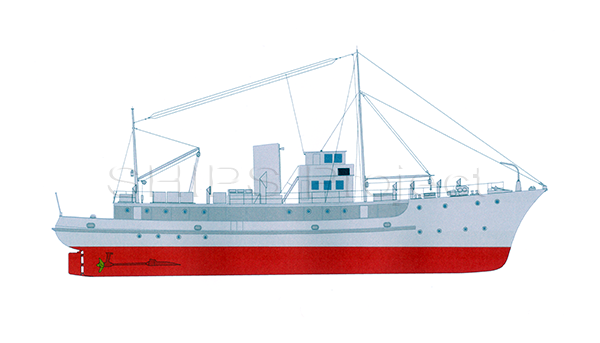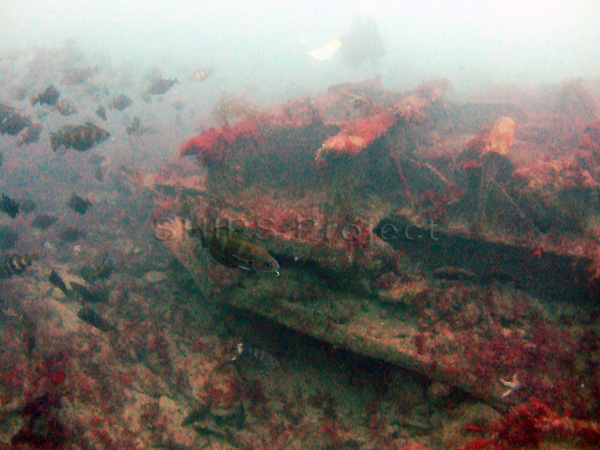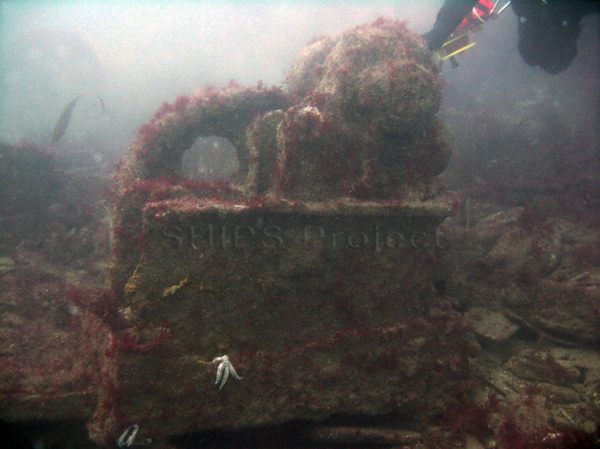FS Poulmic
The Poulmic is a French transport ship from World War II lying on a rocky seabed south of Plymouth Breakwater. The 350-ton vessel had a length of 121.5 feet, a beam of 26.5 feet and a depth of 10 feet, had a 540-horse power diesel engine that could move the ship at up to 12 knots.
She was built in 1937 by Forges & Chantiers de la Mediterranee in Graville, now part of Le Havre, with sister ship Lanveoc. Before the occupation of France by the Germans in 1940 Poulmic was used to transport personnel between the arsenal at Brest and the naval base at Lanveoc-Poulmic.
Just before the fall of France to the Germans in WWII a number of French naval vessels escaped to British controlled ports. French vessels arriving in Plymouth included the huge submarine Surcouf, the battleships Paris and Courbet and the transport ship Poulmic. Admiral Darlan, Minister for the Navy in the Vichy government, sent an order on June 24th to all French vessels in British ports telling them to return to France. The ships were then to remain in French ports with French crews with secret plans for scuttling should any foreign power attempt to seize them. However, Churchill was concerned that under pressure from the Germans the Vichy government would allow their ships to be used against the Allies. So on the night of 3rd July 1940 the French ships in British ports were boarded and taken over by the Royal Navy as part of Operation Catapult. Three British and one French sailor had been killed and other seamen wounded during the taking of the submarine Surcouf.
The Poulmic was handed over to the Free French Naval Forces (Les Forces Navales Francaises Libres, FNFL) on 11 August 1940 commanded by Admiral Emile Muselier under Charles de Gaulle. Muselier was the only one of the fifty French admirals to continue fighting alongside the allies after the fall of France. After serving as a patrol vessel under captain Paul Vibert, Poulmic was used as a minesweeper operating from Plymouth. On the 7th November 1940 while on mine watching duty the Poulmic set of an acoustic mine and sank south of Plymouth Breakwater, 11 crew were lost and 7 rescued at which time Vibert was severely wounded. Poulmic was the first ship loss for the FNFL.
Crew lost:
Note that this list is not complete.
Name |
First Name |
Date of Birth |
Rank |
BLAVETTE |
Eugène, Noël, Arsène |
05 02 1909 |
Second maître mécanicien |
LABORDE |
Gilbert, Laurent |
30 05 1904 |
Quartier-maître de manœuvre |
LEMONNIER |
Auguste, Pierre |
03 04 1908 |
Second maître de manœuvre |
MILANDRE |
Georges, Robert |
18 06 1903 |
Second maître de manœuvre |
PERRON |
Joseph, Louis |
26 02 1909 |
Second maître mécanicien |
PLACIDE |
Paul, Robert |
19 07 1913 |
Second maître de manœuvre |
RIGOURS |
Joseph, Yves, Corentin |
15 05 1900 |
Second maître de manœuvre |
SEVESTRE |
Joseph, Aimé |
12 10 1899 |
Second maître mécanicien |
Crew saved:
Note that this list is not complete.
Name |
First Name |
Date of Birth |
Rank |
Vessels |
|
DICQUEMARE |
Guy, Lucien |
19 08 1902 |
Maître mécanicien |
Courbet, Poulmic, vedettes rapides ,MTB |
|
LAIDET |
Louis, René |
09 07 1912 |
Maître mécanicien |
Poulmic, Etoile, Belle Poule, CH10 Bayonne, Roselys |
Died 30 03 1991 at Amiens |
VIBERT |
Paul |
28 09 1912 |
Officer 3rd Class |
Poulmic, Minerve, Submarine chaser No. 8 |
Died 20 05 1970 |
LEBLOND |
André, Emile, Alphonse |
25 01 1918 |
Quartier-maître chauffeur |
Poulmic, Le Triomphant, E M Londres |
|
Diving the Poulmic
The vessel sustained heavy damage and is now scattered across the seabed between reef outcrops a few metres high running approximately north/south. Most of the debris is low lying and covered with seaweed during the summer months making it difficult to distinguish wreck debris from the underlying seabed. Small bits of broken pottery are scattered across the site. Machinery, such as the engine and deck winches, and ship’s structure remain on the seabed to be explored.
So far the bows of three vessels have been found in the area by the SHIPS Project team suggesting that the remains on the seabed are actually from three different ships. Work is now being done on the site by the Project team to identify the different sections of each vessel. Artillery shells surrounded the site in years past butmany have been removed from the seabed by divers and those that remain may still be dangerous. Two cannon balls of unknown origin were also seen on the site over twenty years ago.
The wreck lies in a depth of 14m (plus tide height) with the main sections scattered in a debris field over 70m long. The largest remaining part of the ship is at 50° 19.193 N 004° 09.696 W, this is the engine bed and bottom plates, the engines have been removed but the bent remains of the starboard side prop shaft is still in place. Another section of the hull is lying alongside but at right angles to the engine bed. To the south east is a well buried collection of debris from the stern of the vessel, part of the prop shaft tunnel and a davit for a ship's boat. Other parts of the ship can be found to the east and west of the main section.
Slack water on site is 3 hours before and after high water Devonport with the maximum current at full flow of 1kt on a spring tide and 0.5kt on neaps. Visibility varies from 1 to 10m and is best after a long period without any rain. Winter and spring dives would be ideal for the Poulmic site as the seaweed will have died back and it will be easier to identify parts of the shipwreck.
The Poulmic has been adopted by The SHIPS Project under the Nautical Archaeology Society Adopt-a-Wreck Scheme.
![]() If you have any more information about this ship then please contact us.
If you have any more information about this ship then please contact us.
Images
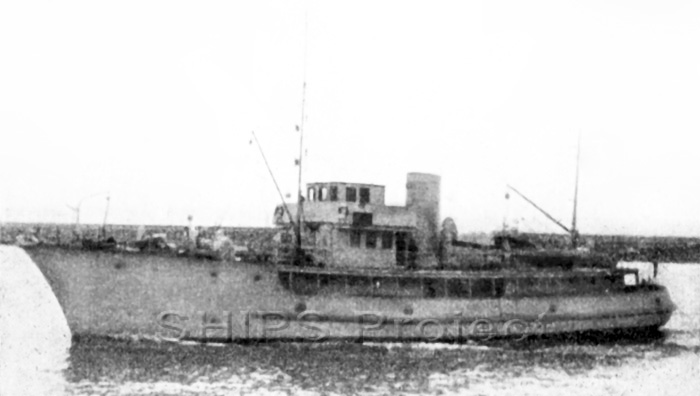
Photograph of the Poulmic at sea |
Drawing of the Poulmic (copyright SHIPS Project) |
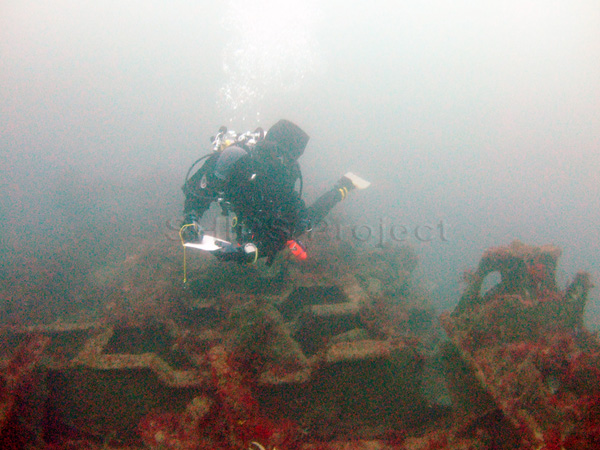
Remains of the engine bed on the main site (Allen Murray) |
Side plating and frames (Allen Murray) |
Deck winch (Richard Wood) |

